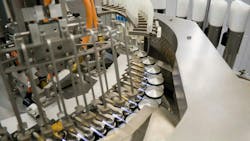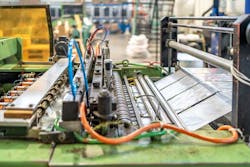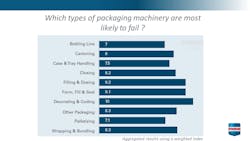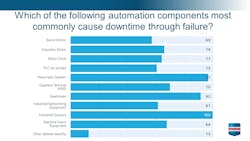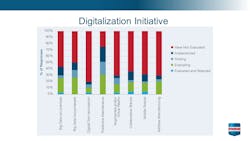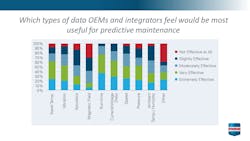A Need for Digital Solutions in Packaging Applications
The priorities of packaging and processing operations have shifted in recent years, with workforce availability becoming the greatest area of concern. As such, it has brought about an increased need for automation and other digital solutions.
Prior to 2020, the focus for many packaging and processing operations – typically referring to consumer packaged goods (CPG) from companies such as Frito Lay and Kraft – was flexibility, quick changeover, productivity and asset reliability. However, once the global pandemic hit in early 2020 “priorities changed significantly,” said Jorge Izquierdo, vice president of market development, PMMI - The Association of Packaging and Processing Technologies, during the National Fluid Power Association (NFPA) quarterly seminar “Advanced Pneumatic Solutions for Packaging Machines.”
Finding those with the knowledge and skills necessary to operate, service and run equipment became more difficult, and remains a challenge for this industry as it does for many others.
Because of this, CPG companies are looking to suppliers of automation technology – everything from packaging equipment to components and controllers – for solutions that will help address workforce issues. “That [includes] technologies that are much more intuitive,” said Izquierdo. “The aim is to improve human machine interfaces, make [machines] easier to service and also make remote services [more available].”
How Technology Can Help Manufacturers
Incorporating intuitive automation solutions can help manufacturers reduce the time it takes to train their workforce so they can quickly get up to speed on using and servicing machines. This helps to maintain productivity, another key priority for many CPG companies.
With the training and ease of use capabilities automation can provide, it can be better assured employees use machinery appropriately and reduce potential downtime issues. According to data from a PMMI member survey Izquierdo shared during the webinar, he said operator error generates over 20% of an operation’s downtime which is very significant. Being able to minimize downtime with automation can greatly benefit manufacturers.
Automation and other digital solutions also offer the possibility of shortening the time it takes to service a machine. Use of intuitive graphic images or augmented reality glasses can help guide workers through the appropriate steps to follow to fix a problem, enabling them to address it more quickly.
READ MORE: Opportunities and Challenges for Fluid Power in Automation
Often these systems can quickly identify the issue, or help in determining what it is, further simplifying and thus quickening the servicing process.
Justin Katz, Manager, Product Management Vacuum Automation at Schmalz, Inc., who also presented during the NFPA seminar, said his company is seeing increased demand from the market for integration of digital solutions such as software and apps which can quickly provide users with insight into what is happening with their industrial equipment. Many of the company’s products are pneumatics-based and are now integrated with analysis and diagnostic functions to make them easier to use.
“It means you can buy this product and right out of the box it’s going to have some of this next-generation intelligence built in so you can have information exchange right on the device,” he said. “It gives you a condition monitoring function that you maybe didn’t have with a more basic type of component. This is really powerful because you can [install the component] and immediately start realizing the benefits.”
Increased Adoption of Remote Accessibility
Prior to the pandemic, much of the equipment CPG manufacturers were using in their plants had the capability to be accessed remotely but was not being used consistently, said Izquierdo. The lack of understanding between the information technology (IT) and operations technology (OT) parts of the business as well as cybersecurity concerns were key factors.
“There was a significant hesitation to provide that access,” he said.
However, this all changed when the pandemic occurred, and service technicians were not allowed to enter manufacturing facilities. “All these priorities changed significantly and suddenly remote access and embracement of [new] technologies exploded.”
Doing so helped many CPG manufacturers maintain their business during the pandemic as any downtime could have significantly hindered their operations. Allowing service technicians to remotely access their machines enabled issues to be addressed as they happened so a machine could be back up and running as quickly as possible.
According to Izquierdo, adoption of remote access technologies has been one of the biggest changes to take place in the packaging and processing industry in recent years. This trend will likely continue due to the ease it provides all parties involved and the lack of qualified technicians in the field – another aspect of the workforce challenges facing so many industries.
Determining the Cause of Downtime
PMMI’s survey data showed packaging machinery is the most likely cause of downtime in a CPG company’s operations, necessitating use of tools to help mitigate it. Decorating and coding equipment is the main culprit for downtime, according to the PPMI survey results, followed by filling and dosing equipment and then form, fill and seal equipment.
There are many reasons for these machines experiencing downtime issues – such as operator error and general wear and tear – but when drilling down on specific machine technologies, survey respondents said industrial sensors were the number one cause followed closely by pneumatics.
Izquierdo said these results are interesting given the increased use of sensors for data collection and the growing adoption of the industrial internet of things (IIoT). “It’s interesting we’re going in that direction, and we still have some homework to do involving industrial sensors,” he said.
In addition, he said there is likely “opportunity to make those pneumatic systems smarter” to help reduce the amount of downtime they are causing in packaging machinery.
Predictive Maintenance Leads Digitalization Initiatives
Most CPG companies are doing in-house maintenance, as indicated in the PMMI survey, which Izquierdo said is very common. Maintenance strategies vary – about 35% of survey respondents said they use portable equipment for measuring aspects such as temperature and vibration, 45% have sensors integrated in their machines and about 30% use run-to-fail for at least some of their machines.
More than 50% of respondents said they consider their maintenance strategy to be optimized, which Izquierdo said is an interesting number considering 30% of CPG companies are running their equipment to fail.
While many companies consider their maintenance strategies to be optimized, the PMMI survey also showed predictive maintenance technologies to be the top digital solution in which they are investing resources – demonstrating the further optimization it could bring. More than 40% of respondents said they are piloting or implementing it, and another 30% are evaluating it. “That’s where most of the companies are finding the…low-hanging fruit for digital technologies,” said Izquierdo.
As part of its survey, PMMI asked OEMs and system integrators what they were measuring in order to implement their predictive maintenance solutions. Run time, current and voltage draw, and speed were noted as the most valuable when developing predictive maintenance tools.
OEMs and system integrators see the highest revenue potential in predictive and preventative maintenance solutions as they can help to prevent downtime and thus increase productivity – leading to more goods produced and sold. Remote assistance was also highly regarded by these survey respondents, further demonstrating the importance of keeping machines operational.
The PMMI survey showed CPG companies are investing in other digital technologies as well such as big data, digital twins, augmented reality and others, but given the productivity benefits and revenue potential of smarter maintenance solutions, adoption of these digital technologies will likely remain high in the foreseeable future. They should therefore also be an area of focus for developers of pneumatic systems and other technologies used in or with packaging machinery.
“The point is the demand for predictive maintenance and remote assistance is there, as well as the opportunity to create smarter components and pieces of equipment,” concluded Izquierdo. “I think there is business to take advantage of and great opportunity for component manufacturers, OEMs and system integrators to provide better solutions to [the packaging and processing industry].”
About the Author
Sara Jensen
Executive Editor, Power & Motion
Sara Jensen is executive editor of Power & Motion, directing expanded coverage into the modern fluid power space, as well as mechatronic and smart technologies. She has over 15 years of publishing experience. Prior to Power & Motion she spent 11 years with a trade publication for engineers of heavy-duty equipment, the last 3 of which were as the editor and brand lead. Over the course of her time in the B2B industry, Sara has gained an extensive knowledge of various heavy-duty equipment industries — including construction, agriculture, mining and on-road trucks —along with the systems and market trends which impact them such as fluid power and electronic motion control technologies.
You can follow Sara and Power & Motion via the following social media handles:
X (formerly Twitter): @TechnlgyEditor and @PowerMotionTech
LinkedIn: @SaraJensen and @Power&Motion
Facebook: @PowerMotionTech
Sharon Spielman
Technical Editor, Machine Design and Power & Motion
Sharon Spielman is a technical editor for Power & Motion and its affiliate publication Machine Design. As technical editor, her beat includes 3D printing/CAD; mechanical and motion systems, with an emphasis on pneumatics and linear motion; automation; robotics; and AR/VR.
Sharon has more than three decades of experience as a writer and editor for a range of B2B brands, including those that cover electrical design and manufacturing; interconnection technology; food and beverage manufacturing; process heating and cooling; finishing; and package converting.

Leaders relevant to this article:
